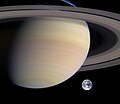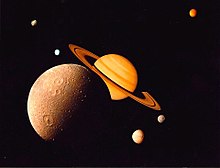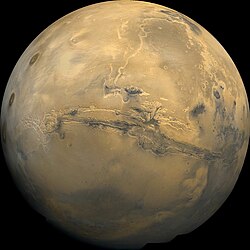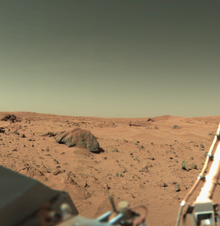1.) This planet is named after Saturn, the Roman god of agriculture, the equivalent of the Greek’s Cronus.
2.) Saturn is the 2nd largest planet in the Solar System after Jupiter.
3.) It is the 6th planet in order of distance from the Sun.
4.) The planet’s most distinctive feature is a giant system of rings that surrounds the planet at its equator, stretching over twice the width of the planet itself.
5.) 1n 1610, the first person to see the rings was the Italian scientist Galileo with the used of his telescope.
6.) Saturn when viewed from Earth appears as a yellowish object and is one of the brightest in the night sky.
7.) Saturn takes about 29.5 years to orbit the Sun at an average distance of 1,435 billion km.
8.) Saturn rotates on its axis in about 10.5 hours and is tilted at about 27°, giving the planet distinct seasons.
9.) The diameter of Saturn is about 121,000 km (75,000 mi), and its mass is equal to the mass of about 95 Earths, making it the second largest planet in our solar system after Jupiter.
10.) Saturn is 10 percent wider at its equator than at its poles and has a more oblate (flattened sphere) shape than any other planet.
11.) The National Aeronautics and Space Administration (NASA) launched the orbiter Cassini spacecraft toward Saturn in October 1997 and reached Saturn in July 2004.
12.) Cassini had detected carbon molecules and geysers on Saturn’s moon Enceladus
13.) Saturn is the least dense of the solar system’s planets. The mean density of Saturn is eight times less than that of Earth because the planet consists mainly of the lightweight gas hydrogen.
14.) Saturn to radiate into space three times as much heat as it receives from the Sun.
15.) Saturn receives about 1.1 percent as much sunlight as Earth does.
As compared to the Earth
16.) Saturn's atmospheric constituents are, in order by mass, hydrogen (88 percent) and helium (11 percent); and traces of methane, ammonia, ammonia crystals, and such other gases as ethane, acetylene, and phosphine comprise the remainder.
17.) The temperatures of Saturn's cloud tops are close to –176°C, about 27 degrees Celsius lower than such locations on Jupiter.
18.) Saturn’s rings are named in order of their discovery, and from the planet outward they are known as the D, C, B, A, F, G, and E rings.
19.) The Cassini probe discovered an additional faint ring between the G ring and the F ring in 2006.
20.) The main rings are now known to comprise more than 100,000 individual ringlets, each of which circles the planet.
21.) The visible rings stretch out to a distance of 136,200 km from Saturn's center, but in many regions they may be only 5 m (16.4 ft) thick.
22.) They are thought to consist of aggregates of rock, frozen gases, and water ice ranging in size from less than 0.0005 cm in diameter to about 10 m in diameter—from dust to boulder size.
23.) The apparent separation between the A and B rings is called Cassini's division, after its discoverer, the French astronomer Giovanni Cassini.
24.) Saturn has at least 62 moons that range up to 2,575 km in radius and consist mostly of the lighter, icy substances. Only 53 have formal names. There are also hundreds of moonlets on the planet’s rings.
25.) Twelve moons of Saturn were discovered in 2005, 9 moons were discovered in 2006 and 4 moons were discovered in 2007.
26.) The five larger inner satellites of Saturn are Mimas, Enceladus, Tethys, Dione, and Rhea. These moons are roughly spherical in shape and composed mostly of water ice and are heavily cratered by meteorite impacts.
27.) The outer satellites of Saturn are Hyperion and Iapetus. These satellites also consist mainly of water ice.
28.) Phoebe, the farthest large satellite, moves in a retrograde orbit (in the opposite direction of the orbits of most of the other satellites) that is at a sharp angle to Saturn's equator.
29.) Saturn’s largest moon is the Titan. It orbits the planet between the inner and outer satellites and has a radius of 2,575 km.
30.) Titan is larger than the planet Mercury and features large rock-like objects probably made of ice.
See also
- 40 Amazing and Interesting Scientific Facts About Planet Mercury
- 35+Amazing and Interesting Scientific Facts About Planet Venus
- Amazing and Interesting Facts About the Planet Jupiter
- Amazing Things About Our Solar System
- 50 Amazing and Interesting Facts About the Moon
- Top Ten Largest Stars in the Universe
- 15 Quick and Amazing Facts About the Earth and the Universe
- Interesting Facts About the Satellite Titan
- Interesting Facts About the Satellite Europa











